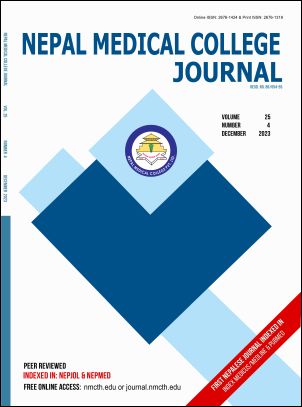A comparison of ratio of patient’s height to thyromental distance with modified mallampati test and upper lip bite test for prediction of difficult laryngoscopy
DOI:
https://doi.org/10.3126/nmcj.v25i4.60923Keywords:
Difficult laryngoscopy, modified mallampati test, thyromental distance, upper lip bite testAbstract
Various airway evaluation tests are performed to predict difficult intubation. The ratio of Height to thyromental distance has been reported to have a good predictability. This study tested the performance of ratio of height to thyromental distance and compared it with commonly performed airway evaluation tests: the modified Mallampati test and upper lip bite test. This descriptive study was conducted in 120 patients presenting for surgery under general anesthesia with endotracheal intubation. Preoperative airway assessment was done using Modified Mallampati test, upper lip bite test and ratio of height to thyromental distance. The Cormack and Lehane grading was done during laryngoscopy to determine easy or difficult visualization of larynx. Sensitivity, specificity, positive predictive value, negative predictive value and accuracy of three tests were calculated. Difficult laryngoscopy was seen in 9 patients (7.5%). The sensitivity, specificity, positive predictive value, negative predictive value respectively for the tests were modified Mallampati test (22.2%, 89.2%, 14.3% and 93.4%), upper lip bite test (22.2%, 100%, 100% and 94.1%), ratio of height to thyromental distance (77.8%, 95.5%, 58.3% and 94.16%). In conclusion, we found that the ratio of patient’s height to thyromental distance performed better than MMT and ULBT in predicting difficult visualization of larynx in our population.
Downloads
Downloads
Published
How to Cite
Issue
Section
License
Copyright (c) 2023 Nepal Medical College Journal

This work is licensed under a Creative Commons Attribution 4.0 International License.
This license enables reusers to distribute, remix, adapt, and build upon the material in any medium or format, so long as attribution is given to the creator. The license allows for commercial use.




